Zhixun Li
EraRAG: Efficient and Incremental Retrieval Augmented Generation for Growing Corpora
Jun 26, 2025Abstract:Graph-based Retrieval-Augmented Generation (Graph-RAG) enhances large language models (LLMs) by structuring retrieval over an external corpus. However, existing approaches typically assume a static corpus, requiring expensive full-graph reconstruction whenever new documents arrive, limiting their scalability in dynamic, evolving environments. To address these limitations, we introduce EraRAG, a novel multi-layered Graph-RAG framework that supports efficient and scalable dynamic updates. Our method leverages hyperplane-based Locality-Sensitive Hashing (LSH) to partition and organize the original corpus into hierarchical graph structures, enabling efficient and localized insertions of new data without disrupting the existing topology. The design eliminates the need for retraining or costly recomputation while preserving high retrieval accuracy and low latency. Experiments on large-scale benchmarks demonstrate that EraRag achieves up to an order of magnitude reduction in update time and token consumption compared to existing Graph-RAG systems, while providing superior accuracy performance. This work offers a practical path forward for RAG systems that must operate over continually growing corpora, bridging the gap between retrieval efficiency and adaptability. Our code and data are available at https://github.com/EverM0re/EraRAG-Official.
Can LLMs Alleviate Catastrophic Forgetting in Graph Continual Learning? A Systematic Study
May 24, 2025Abstract:Nowadays, real-world data, including graph-structure data, often arrives in a streaming manner, which means that learning systems need to continuously acquire new knowledge without forgetting previously learned information. Although substantial existing works attempt to address catastrophic forgetting in graph machine learning, they are all based on training from scratch with streaming data. With the rise of pretrained models, an increasing number of studies have leveraged their strong generalization ability for continual learning. Therefore, in this work, we attempt to answer whether large language models (LLMs) can mitigate catastrophic forgetting in Graph Continual Learning (GCL). We first point out that current experimental setups for GCL have significant flaws, as the evaluation stage may lead to task ID leakage. Then, we evaluate the performance of LLMs in more realistic scenarios and find that even minor modifications can lead to outstanding results. Finally, based on extensive experiments, we propose a simple-yet-effective method, Simple Graph Continual Learning (SimGCL), that surpasses the previous state-of-the-art GNN-based baseline by around 20% under the rehearsal-free constraint. To facilitate reproducibility, we have developed an easy-to-use benchmark LLM4GCL for training and evaluating existing GCL methods. The code is available at: https://github.com/ZhixunLEE/LLM4GCL.
Materials Generation in the Era of Artificial Intelligence: A Comprehensive Survey
May 22, 2025Abstract:Materials are the foundation of modern society, underpinning advancements in energy, electronics, healthcare, transportation, and infrastructure. The ability to discover and design new materials with tailored properties is critical to solving some of the most pressing global challenges. In recent years, the growing availability of high-quality materials data combined with rapid advances in Artificial Intelligence (AI) has opened new opportunities for accelerating materials discovery. Data-driven generative models provide a powerful tool for materials design by directly create novel materials that satisfy predefined property requirements. Despite the proliferation of related work, there remains a notable lack of up-to-date and systematic surveys in this area. To fill this gap, this paper provides a comprehensive overview of recent progress in AI-driven materials generation. We first organize various types of materials and illustrate multiple representations of crystalline materials. We then provide a detailed summary and taxonomy of current AI-driven materials generation approaches. Furthermore, we discuss the common evaluation metrics and summarize open-source codes and benchmark datasets. Finally, we conclude with potential future directions and challenges in this fast-growing field. The related sources can be found at https://github.com/ZhixunLEE/Awesome-AI-for-Materials-Generation.
IceBerg: Debiased Self-Training for Class-Imbalanced Node Classification
Feb 10, 2025Abstract:Graph Neural Networks (GNNs) have achieved great success in dealing with non-Euclidean graph-structured data and have been widely deployed in many real-world applications. However, their effectiveness is often jeopardized under class-imbalanced training sets. Most existing studies have analyzed class-imbalanced node classification from a supervised learning perspective, but they do not fully utilize the large number of unlabeled nodes in semi-supervised scenarios. We claim that the supervised signal is just the tip of the iceberg and a large number of unlabeled nodes have not yet been effectively utilized. In this work, we propose IceBerg, a debiased self-training framework to address the class-imbalanced and few-shot challenges for GNNs at the same time. Specifically, to figure out the Matthew effect and label distribution shift in self-training, we propose Double Balancing, which can largely improve the performance of existing baselines with just a few lines of code as a simple plug-and-play module. Secondly, to enhance the long-range propagation capability of GNNs, we disentangle the propagation and transformation operations of GNNs. Therefore, the weak supervision signals can propagate more effectively to address the few-shot issue. In summary, we find that leveraging unlabeled nodes can significantly enhance the performance of GNNs in class-imbalanced and few-shot scenarios, and even small, surgical modifications can lead to substantial performance improvements. Systematic experiments on benchmark datasets show that our method can deliver considerable performance gain over existing class-imbalanced node classification baselines. Additionally, due to IceBerg's outstanding ability to leverage unsupervised signals, it also achieves state-of-the-art results in few-shot node classification scenarios. The code of IceBerg is available at: https://github.com/ZhixunLEE/IceBerg.
GDeR: Safeguarding Efficiency, Balancing, and Robustness via Prototypical Graph Pruning
Oct 17, 2024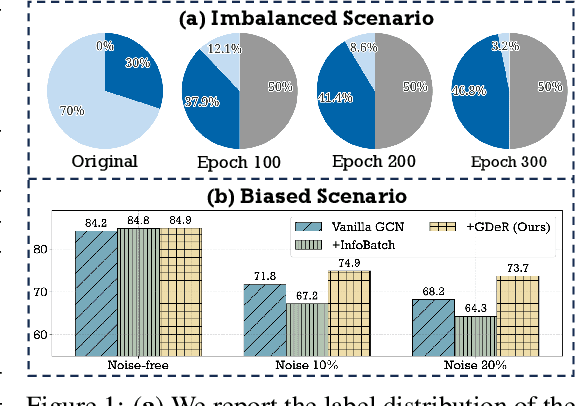
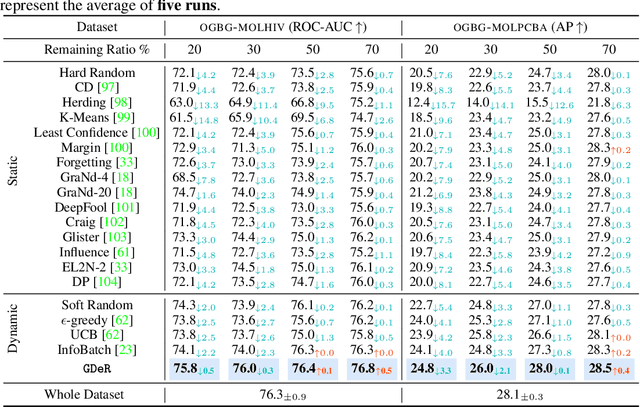
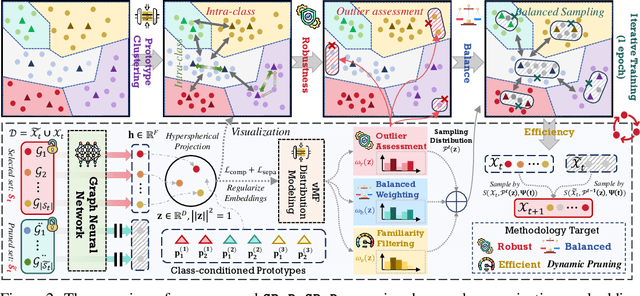
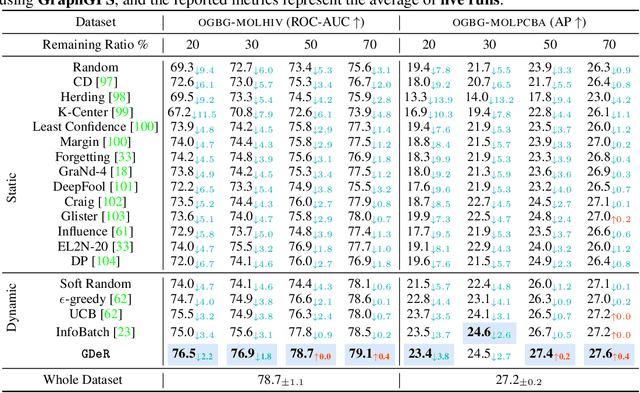
Abstract:Training high-quality deep models necessitates vast amounts of data, resulting in overwhelming computational and memory demands. Recently, data pruning, distillation, and coreset selection have been developed to streamline data volume by retaining, synthesizing, or selecting a small yet informative subset from the full set. Among these methods, data pruning incurs the least additional training cost and offers the most practical acceleration benefits. However, it is the most vulnerable, often suffering significant performance degradation with imbalanced or biased data schema, thus raising concerns about its accuracy and reliability in on-device deployment. Therefore, there is a looming need for a new data pruning paradigm that maintains the efficiency of previous practices while ensuring balance and robustness. Unlike the fields of computer vision and natural language processing, where mature solutions have been developed to address these issues, graph neural networks (GNNs) continue to struggle with increasingly large-scale, imbalanced, and noisy datasets, lacking a unified dataset pruning solution. To achieve this, we introduce a novel dynamic soft-pruning method, GDeR, designed to update the training ``basket'' during the process using trainable prototypes. GDeR first constructs a well-modeled graph embedding hypersphere and then samples \textit{representative, balanced, and unbiased subsets} from this embedding space, which achieves the goal we called Graph Training Debugging. Extensive experiments on five datasets across three GNN backbones, demonstrate that GDeR (I) achieves or surpasses the performance of the full dataset with 30%~50% fewer training samples, (II) attains up to a 2.81x lossless training speedup, and (III) outperforms state-of-the-art pruning methods in imbalanced training and noisy training scenarios by 0.3%~4.3% and 3.6%~7.8%, respectively.
Cut the Crap: An Economical Communication Pipeline for LLM-based Multi-Agent Systems
Oct 03, 2024



Abstract:Recent advancements in large language model (LLM)-powered agents have shown that collective intelligence can significantly outperform individual capabilities, largely attributed to the meticulously designed inter-agent communication topologies. Though impressive in performance, existing multi-agent pipelines inherently introduce substantial token overhead, as well as increased economic costs, which pose challenges for their large-scale deployments. In response to this challenge, we propose an economical, simple, and robust multi-agent communication framework, termed $\texttt{AgentPrune}$, which can seamlessly integrate into mainstream multi-agent systems and prunes redundant or even malicious communication messages. Technically, $\texttt{AgentPrune}$ is the first to identify and formally define the \textit{communication redundancy} issue present in current LLM-based multi-agent pipelines, and efficiently performs one-shot pruning on the spatial-temporal message-passing graph, yielding a token-economic and high-performing communication topology. Extensive experiments across six benchmarks demonstrate that $\texttt{AgentPrune}$ \textbf{(I)} achieves comparable results as state-of-the-art topologies at merely $\$5.6$ cost compared to their $\$43.7$, \textbf{(II)} integrates seamlessly into existing multi-agent frameworks with $28.1\%\sim72.8\%\downarrow$ token reduction, and \textbf{(III)} successfully defend against two types of agent-based adversarial attacks with $3.5\%\sim10.8\%\uparrow$ performance boost.
Beyond Efficiency: Molecular Data Pruning for Enhanced Generalization
Sep 02, 2024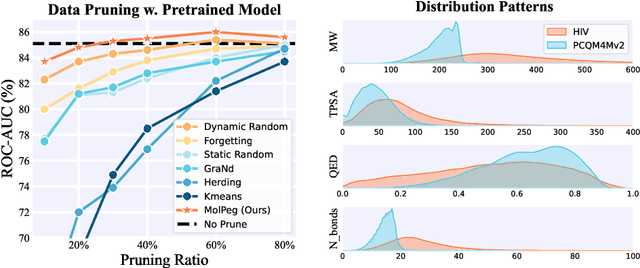
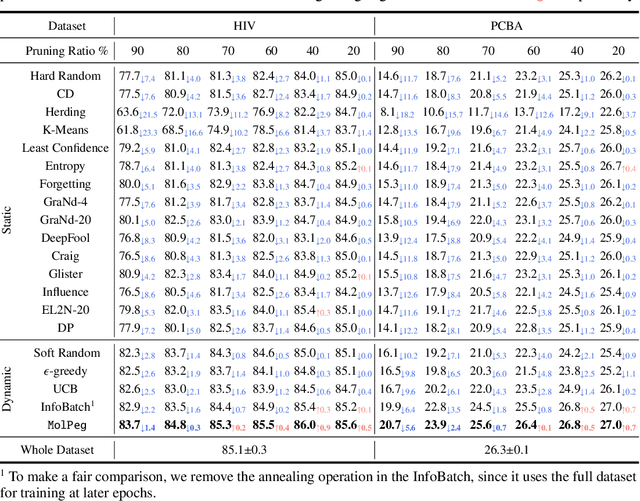


Abstract:With the emergence of various molecular tasks and massive datasets, how to perform efficient training has become an urgent yet under-explored issue in the area. Data pruning (DP), as an oft-stated approach to saving training burdens, filters out less influential samples to form a coreset for training. However, the increasing reliance on pretrained models for molecular tasks renders traditional in-domain DP methods incompatible. Therefore, we propose a Molecular data Pruning framework for enhanced Generalization (MolPeg), which focuses on the source-free data pruning scenario, where data pruning is applied with pretrained models. By maintaining two models with different updating paces during training, we introduce a novel scoring function to measure the informativeness of samples based on the loss discrepancy. As a plug-and-play framework, MolPeg realizes the perception of both source and target domain and consistently outperforms existing DP methods across four downstream tasks. Remarkably, it can surpass the performance obtained from full-dataset training, even when pruning up to 60-70% of the data on HIV and PCBA dataset. Our work suggests that the discovery of effective data-pruning metrics could provide a viable path to both enhanced efficiency and superior generalization in transfer learning.
Rethinking Fair Graph Neural Networks from Re-balancing
Jul 16, 2024Abstract:Driven by the powerful representation ability of Graph Neural Networks (GNNs), plentiful GNN models have been widely deployed in many real-world applications. Nevertheless, due to distribution disparities between different demographic groups, fairness in high-stake decision-making systems is receiving increasing attention. Although lots of recent works devoted to improving the fairness of GNNs and achieved considerable success, they all require significant architectural changes or additional loss functions requiring more hyper-parameter tuning. Surprisingly, we find that simple re-balancing methods can easily match or surpass existing fair GNN methods. We claim that the imbalance across different demographic groups is a significant source of unfairness, resulting in imbalanced contributions from each group to the parameters updating. However, these simple re-balancing methods have their own shortcomings during training. In this paper, we propose FairGB, Fair Graph Neural Network via re-Balancing, which mitigates the unfairness of GNNs by group balancing. Technically, FairGB consists of two modules: counterfactual node mixup and contribution alignment loss. Firstly, we select counterfactual pairs across inter-domain and inter-class, and interpolate the ego-networks to generate new samples. Guided by analysis, we can reveal the debiasing mechanism of our model by the causal view and prove that our strategy can make sensitive attributes statistically independent from target labels. Secondly, we reweigh the contribution of each group according to gradients. By combining these two modules, they can mutually promote each other. Experimental results on benchmark datasets show that our method can achieve state-of-the-art results concerning both utility and fairness metrics. Code is available at https://github.com/ZhixunLEE/FairGB.
All-in-One: Heterogeneous Interaction Modeling for Cold-Start Rating Prediction
Mar 28, 2024Abstract:Cold-start rating prediction is a fundamental problem in recommender systems that has been extensively studied. Many methods have been proposed that exploit explicit relations among existing data, such as collaborative filtering, social recommendations and heterogeneous information network, to alleviate the data insufficiency issue for cold-start users and items. However, the explicit relations constructed based on data between different roles may be unreliable and irrelevant, which limits the performance ceiling of the specific recommendation task. Motivated by this, in this paper, we propose a flexible framework dubbed heterogeneous interaction rating network (HIRE). HIRE dose not solely rely on the pre-defined interaction pattern or the manually constructed heterogeneous information network. Instead, we devise a Heterogeneous Interaction Module (HIM) to jointly model the heterogeneous interactions and directly infer the important interactions via the observed data. In the experiments, we evaluate our model under three cold-start settings on three real-world datasets. The experimental results show that HIRE outperforms other baselines by a large margin. Furthermore, we visualize the inferred interactions of HIRE to confirm the contribution of our model.
Evolving to the Future: Unseen Event Adaptive Fake News Detection on Social Media
Feb 29, 2024Abstract:With the rapid development of social media, the wide dissemination of fake news on social media is increasingly threatening both individuals and society. In the dynamic landscape of social media, fake news detection aims to develop a model trained on news reporting past events. The objective is to predict and identify fake news about future events, which often relate to subjects entirely different from those in the past. However, existing fake detection methods exhibit a lack of robustness and cannot generalize to unseen events. To address this, we introduce Future ADaptive Event-based Fake news Detection (FADE) framework. Specifically, we train a target predictor through an adaptive augmentation strategy and graph contrastive learning to make more robust overall predictions. Simultaneously, we independently train an event-only predictor to obtain biased predictions. Then we further mitigate event bias by obtaining the final prediction by subtracting the output of the event-only predictor from the output of the target predictor. Encouraging results from experiments designed to emulate real-world social media conditions validate the effectiveness of our method in comparison to existing state-of-the-art approaches.
 Add to Chrome
Add to Chrome Add to Firefox
Add to Firefox Add to Edge
Add to Edge